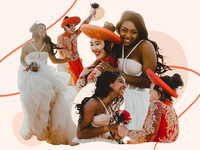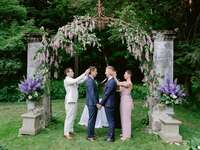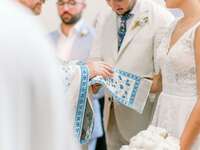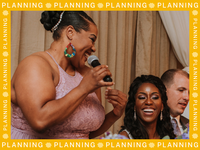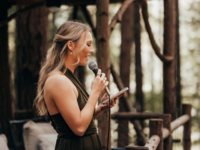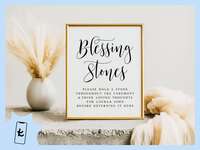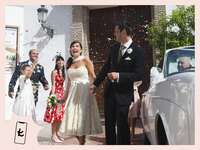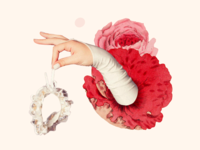An Insider's Peek Into Albanian Wedding Traditions

Albanian wedding traditions showcase some of the most poignant parts of the nation's culture, including family, hospitality and honor. Similar to how wedding traditions vary greatly around the world, Albanian customs look different depending on what part of the country the couple is from and what religion they follow.
To get a better grasp on what happens at a traditional Albanian wedding, we spoke with Rudina Bakalli, an Albanian blogger, to get an insider's look into the uniquely beautiful customs of her nation. If you're looking to incorporate some of these Albanian wedding traditions and customs, head to The Knot Vendor Marketplace to find an expert ready to make your dreams come to life.
Albanian Wedding Traditions in This Story: History | Prewedding | Attire | Ceremony | Reception | Food & Drink
A Brief History of Albanian Wedding Traditions
Rudina Bakalli describes Albania as a "country in transition", acknowledging that communism had a grip on the nation until the early 1990s. While many of the time-honored traditions are still popular in Albania, modern couples, especially in cities, adapt them to best fit their lifestyle and desires.
A typical Albanian wedding celebration lasts a full week, although this is broken up into different parties, events, dances and ceremonies. What each couple chooses to incorporate into their wedding varies depending on the region the families are from, where they currently live and if they're marrying into another culture.
Prewedding Albanian Traditions
Family is a central part of Albanian culture, which makes the engagements and traditions surrounding them a huge deal. The festivities begin before the wedding as the two families come together.
Engagement Celebration
In many areas of Albania, the engagement celebration is "as big as the wedding" according to Rudina. During this time, both families meet for a banquet where the couple exchanges rings as a "symbol of their commitment." Rudina emphasized how serious this is, noting an engagement is "very difficult to break up."
At this event, it would be normal for close family friends of the groom to go to the bride-to-be's home to ask for her hand. Traditionally, they would bring gold jewelry, such as necklaces, rings, bracelets and watches, to the bride. Now, many parties bring perfume as well, although it was not previously available under the communist rule.
The bride's family will serve desserts, like Turkish Delight, fruit and coffee at the gathering. When drunk together, the coffee symbolizes the families "sealing the agreement or covenant" between the couple to marry. During the engagement celebration, both families agree on a mutually convenient date and a dowry. Sometimes, the families host an afterparty at a restaurant.
The Bride's Dowry
Traditionally, the bride's dowry includes bed linens, clothing and jewelry that "she can bring to her new home." Rudina emphasized that "some brides will have a big dowry, some will be smaller, depending on the family's wealth." In some areas, future husband's will even have requirements of what the bride needs to have in her dowry.
On the flip side, a tradition where the husband's family takes the bride on a shopping trip for items to bring into her new home before the marriage. Rudina noted that families in more rural Albania "still preserve this tradition", although it is less common. During this outing, the future husband will take two or three older people from his family to pick up the bride to take her shopping.
Husband's Family Sends the Bridal Gown
As the week-long wedding nears, the husband's family sends the bridal gown to the bride. Typically on Wednesday or Thursday before the wedding week, a "delegation" of the groom's family will arrive with the gown and other nice clothes for the bride.
In southern Albania, this is done with a suitcase that includes the gown, as well as rice that wishes fertility on the couple, candies which signify "sweetness in the relationship", fresh basil leaves to hope the "relationship would have a good aroma" and flowers so that "their relationship would bloom." During this time, the bride's family would present gifts to the groom's close family, such as parents, siblings, aunts and uncles.
Traditional Albanian Wedding Attire
The most important part of getting dressed for an Albanian wedding is to wear something you feel confident in and can dance in. Guests love to dress up in new clothing, making sure to look polished to honor the couple and their family. However, make sure whatever you put on can hold up to hours and hours of eating and dancing.
Albanian Wedding Colors
Rudina shared that most Albanian weddings pick whatever "bold tones" they like, with the most popular being red, the national color, as well as gold and silver or blue. For her own wedding, Rudina chose a light violet which gave a royal feel to the celebration.
For most weddings, guests should stay away from wearing black, as it is associated with "funerals and mourning and it would bring bad luck." However, over the last two decades, young ladies have begun wearing black to wedding week events in the urban areas and cities as there is more Western influence in the nation.
Albanian Traditional Wedding Clothes
The traditional wedding outfit from Kosovo is called a veshje e ketunit. This ensemble often includes a black skirt, white shirt, black vest and gold or red belt, although many variations of this exist. The vests, known as jelek, are often sewn with gold threads and expensive crystals in ornate patterns. Men sometimes wear white, wool hats called geleshe. While these outfits are less popular in modern day, many couples still don them at some point during the celebration to give a nod to their heritage.
Albanian Wedding Ceremony Traditions
Wedding festivities can look different in every nation, as each culture and religion lends its own flair to the ceremony and reception. In Albania, the wedding ceremony itself is not the main event of the week like it is in the West. It is simply a low-key kickoff to the upcoming festivities.
Thursday or Friday Wedding Ceremony
In Albania, a legal marriage must have two witnesses and be done through the local government. For many, this means the couple and a few close friends and family simply go together to the mayor's office to sign the certificate and legally tie the knot. This ceremony is "not a big deal" according to Rudina and is not the center of Albanian wedding culture. For those following Christianity or Islam, another ceremony may take place in a church or mosque following their own religious traditions and special blessings, but a visit to the mayor will still be needed to make it legally binding.



The ceremony will often take place on Thursday, leaving the weekend to host the large celebratory banquets. Couples will often host a cocktail party or dinner after their legal ceremony for close family and friends.
Albanian Wedding Reception Traditions
While the West typically refers to the party following a wedding as the reception, Albanians often refer to the multiple parties following the legal ceremony as the wedding itself. Traditionally, there would be one party hosted by the bride's family on Saturday and one hosted on Sunday by the groom's family. Nowadays, these are often combined to one party on Saturday.
Albanian Wedding Planning Customs and Vendors
It is very common for Albanians to hire wedding planning companies to decorate and plan the events. Rudina emphasized that it is "very important that the wedding is done very well to honor the family." To do that, some families will choose to borrow money "so they will not be ashamed" of having a small or lackluster party. Albanians are "very fond of decorations" and spend lots of money on flowers and other decor to ensure the venue is beautiful as guests arrive.
Weddings typically take place in large halls and restaurants specifically designed for weddings. These spots can hold up to 500 or 600 people. Even families that cannot afford big weddings would have at least 100 guests, although this would be considered a very small wedding. Family friends, neighbors and relatives are all invited to the wedding to mark the "very important milestone in the life of an Albanian family."
The Bride and Groom Banquets
The bridal banquet often takes place at lunchtime if the groom's family is from further away, but may be later if they are from the same town. During this party, there is usually live music, such as a band or small orchestra, and plenty of dancing. For many years, hiring a DJ was frowned upon, but it is getting more common, especially in urban areas. This banquet is about the bride saying goodbye to her family, which in central Albania, traditionally ends in tears from the bride and the eldest female in the family blessing her with honey and salt to wish her luck and fortune.
Rudina compared the liveliness of an Albanian wedding to that of the hit movie My Big Fat Greek Wedding. Guests should expect plenty of food, drink, dancing and loud music to go into the early hours of the morning.
The Krushqit
To kick off the groom's banquet, a "delegation" of cars, as little as two for some families or more than five for more affluent families, will head over to pick up the bride and bring her to her new home. This time is a community-wide celebration, as the cars are typically quite expensive and decked out in decorations and playing loud music. Everyone involved wears their best outfits for the occasion, and sometimes, the men in the cars shoot rifles in the air to announce their arrival.
During the banquet meal, multiple toasts will be given. Speakers will honor the elder family members, thanking everyone for participating and the work they put in to get everyone to the joyous celebration. As family is intensely important in Albanian culture, it is very common for people to toast that the couple would be blessed with children.
During the dancing, more traditional weddings will have a clear order to the dances and who is involved. Rudina describes it as "quite joyful and crazy" as traditional folk music intermixes with modern music. Oftentimes, professional dancers and drummers will perform the traditional Albanian wedding music.
Traditional Albanian Wedding Dance
At some point, you may find yourself wondering, "What is the Albanian wedding dance called?" For Albanians in Kosovo, is the Shota or Shotë, a dance where the couple and other wedding guests dance around each other, waving a handkerchief in the air.
It started as a dance where the bride would wave her handkerchief around to the music, and eventually the groom would take it and burn it while he dances. This symbolizes the two becoming one. This one-on-one version of the dance is less common now, but is still occasionally seen. Instead, it's more popular to have guests join the couple as everyone dances around to the beat, waving the handkerchiefs above their heads.
The "Napoleon" is one of the other popular traditional Albanian wedding songs, where elder relatives begin showering the couple with money. Often, family members and guests join in to throw money onto the dance floor. This tradition started in central Albania, where the money would typically go to the band. In recent years, bands have spread this tradition around the country.
Guests should come prepared with plenty of small bills in case this dance should take place, as well as some larger bills, as money is the most popular of the traditional Albanian wedding gifts.
Traditional Albanian Wedding Food, Drinks and Desserts
One of the best ways to experience a new culture is to taste its food. Especially in Albania, Rudina shared that food is "quite important" and that "a real, traditional Albanian wedding will have a lot of meat." During a banquet, you will usually be served "plate after plate, course after course of beef." Each plate will be prepared in different ways and in different sauces. While it may be accompanied with potatoes, vegetables and rice on the side are very rare. At the end, cakes and desserts will also be offered.
The Albanian drink of choice is raki, a fruit brandy which typically ranges from 45 to 50% ABV. It is often served at weddings and used for toasts.

